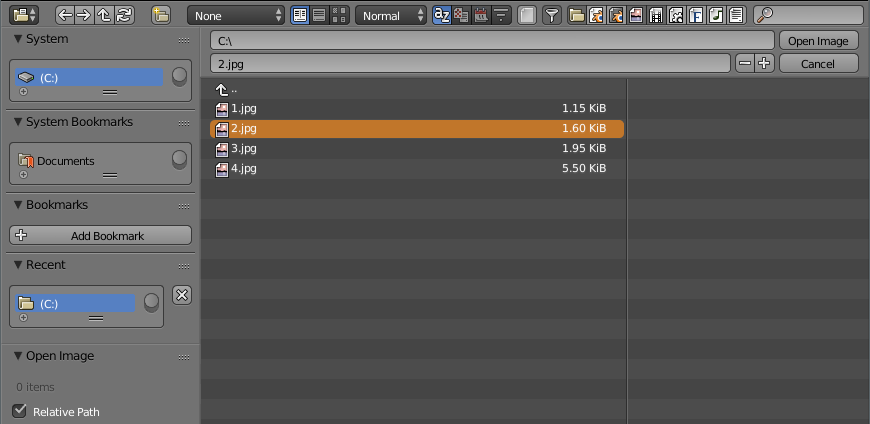Introduction¶

The File Browser.
Usage¶
The File Browser is used in all the file-related operations. It has multiple use cases, while its often used for save/load.
These include:
- Opening and Saving Blend files.
- Import/Export other file formats.
- Picking new locations for existing file-paths (images, video, fonts...).
- Browsing inside other blend-files, when using Linked Libraries.
You can also keep the File Browser open, as with any other editor type, to browse through the file system. In this case, confirm/cancel buttons will be absent.
The main purpose of this is to be able to drag media files:
- Images into the Video Sequence Editor (to set background or apply as material textures).
- Media files into the Video Sequence Editor.
On the other hand, if the File Browser is opened for a file action (opening, saving, importing, etc.), it will appear maximized and waiting for an operation to complete before returning to the former screen layout.
Opening an Image Sequence¶
The filename of the images must contain a digit, indicating the frame.
The sequence could be opened by the selection of the images and
by the confirmation with the Open Image button or Return.
Header¶
- Navigation icon buttons
Tools for navigation of files.
- Left Arrow
Backspace - Move to previous folder.
- Right Arrow
Shift-Backspace - Move to next folder.
- Up Arrow
P - Move up to parent directory.
- Cycle Arrows
R,Numpad . - Refresh current folder.
- Left Arrow
- Create Directory
- Prompts you to enter the name of a newly created directory inside the current one
I. - Recursion
The number of directory levels to show at once in a flat way.
- None (only the current directory)
- Blend File (inside blend-files)
- One level
- Two Levels
- Three levels
- Display type
Controls how files are displayed.
- Short list
- Detailed list
- Thumbnails (show previews)
- Display size
The size of thumbnails or the width of columns.
Tiny, small, normal, large
- Sorting
Sorts files by on of the following methods:
- Alphabetically
- By file type
- By date of last edit
- By file size
- Show hidden
- Shows hidden files (starting with
.)H. - File filtering
- File Type
Filters files by type.
- Folders
- blend-files
- Backup blend-files
- Image files
- Movie files
- Script files
- Font files
- Sound files
- Text files
- Data-Block Type
- Data-block type filtering inside blend-files.
- Search box
- Filter files by name.
File Region¶
- File Path
- The text field for the current path.
Tabwill auto-complete an existing path. If you type a non existing directory path, you will be prompted to create that new directory. - File Name
- Text field to edit the file name and extension.
If the background is red, a file with same name already exist in the folder.
Tabwill auto-complete to existing names in the current directory. - Increment Filename
+,- - Adds/increase or removes/decreases a trailing number to your file name (use to make versions of a file).
- Confirm
The main button to Open Directory/File or Save (As)
Returnor double click withLMBon the entry confirms with that file or data-block.Shift-LMB– Open the file externally (selected in File).Alt-LMB– Open the directory externally (using the system’s file manager).
- Cancel
- Cancels the Open or Save file selection and closes the File browser
Escor by using the Back to Previous in the Info editor header.
Tool Shelf¶
The left region displays different ways to find files and several options.
Clicking with LMB on one of the entries, the File Browser will navigate to that folder.
System¶
The system panel contains a list of drives that are available to navigate through to find files.
System Bookmarks¶
Bookmarks that are common for a particular operating system.
Bookmarks¶
A List View of shortcuts to folders, that you want to be able to access often without having to navigate to them in the file browser.
- Add
+ - This button adds the current directory to the list.
Recent¶
This is a list of recently accessed folders. You can control how many folders appear in this list by going to the File tab of the User Preferences, in the Recent Files number button.
Operator Panel¶
- Link/Append from Library
- See Linked libraries.
- Open, Save, Save As Blender File
- See Opening Files or Saving Files.
- Open, Replace, Save As Image
- See Supported Graphics Formats.
For the common option:
- Relative Path
- See Relative paths.
Main Region¶
Selection¶
- Select
- Both
LMBandRMBworks. - (De)select All
A - Toggles selecting all files.
- Dragging
- Dragging with
LMBstarts a border selection.
Arrow Keys¶
It is also possible to select/deselect files by “walking” through them using the arrow keys:
- Just using an arrow key, the next file in the chosen direction will be selected and all others deselected.
- Holding down
Shiftwhile doing this does not deselect anything so it extends to the selection, plus it allows to deselect files by navigating into a block of already selected ones (minimum two files in sequence). - Holding down
Ctrl-Shiftfurther selects/deselects all files in-between.
If no file is selected, the arrow key navigation selects the first or last file in the directory, depending on the arrow direction.
If you select a directory and hit Enter, you will go into that directory
(and highlighting ‘parent’ entry will bring you up one level).
File Management¶
- Delete Files
Delete,X - Delete the currently selected files.
- Rename
Ctrl-LMB - Can be used on a file or directory to rename it.